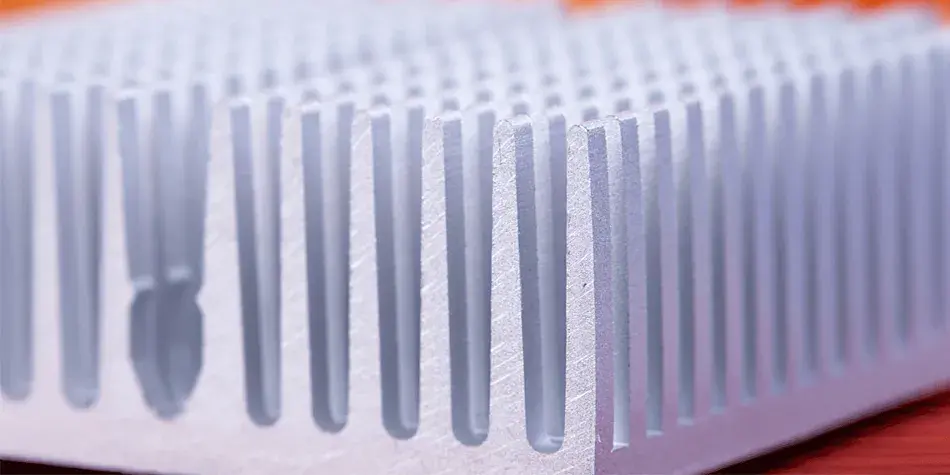Aluminium: The Material of Choice for Next-Gen Cooling
Aluminium’s thermal conductivity-to-weight ratio makes it ideal for demanding environments. For example:
This means lightweight yet thermally capable designs, essential for applications where every gram counts — from avionics to portable electronics. You get performance without the penalty of excess weight or cost.
More Than Metal: Design Freedom Through Extrusion
The real revolution comes from extrusion technology. Unlike die casting or machining, our precision aluminium extrusion process offers:
-
Continuous plate-fin arrays with uniform cross-sections for consistent performance
-
High-aspect-ratio fins that maximise cooling surface area without bulk
-
Complex pin-fin or asymmetric designs tuned to your airflow patterns
-
Slender, optimised fin profiles created directly during extrusion — no secondary bonding required
This approach enables greater structural integrity, reduced production costs, and unmatched design versatility, so you can optimise for both thermal performance and manufacturability.
Surface Treatments That Boost Cooling Power
Heat conduction is just one piece of the puzzle. Radiation also plays a role — and that’s where surface finishing makes a measurable difference.
Black anodising, for example, can increase aluminium emissivity from ~0.14 to nearly 0.9, drastically improving passive heat dissipation when airflow is limited. This makes a major difference in:
-
LED lighting — where low airflow demands efficient passive cooling
-
Outdoor telecom enclosures — facing harsh environmental conditions
-
Passive housings for renewable energy electronics — where uptime and efficiency are paramount
Our in-house finishing ensures your heat sinks don’t just perform well — they perform better than the competition.
Sustainability: Cooling That's Green and Cost-Smart
Choosing aluminium isn’t just good for performance; it’s good for your sustainability goals. Aluminium is 100% recyclable without losing mechanical or thermal properties, and recycled aluminium production uses only 5% of the energy needed for primary production.
For companies targeting Scope 3 emissions reductions, this means you can slash your carbon footprint and market your products as eco-friendly — without compromising performance or cost.
Why BWC Profiles?
We deliver tailored thermal management solutions for some of the most demanding industries:
-
Electronics & Power Conversion: IGBTs, MOSFETs, rectifiers, UPS systems, inverters
-
LED Lighting: Passive sinks for streetlights, architectural luminaires, high-bay fixtures
-
Telecom & Networking: RF amplifiers, base stations, ruggedised outdoor enclosures
-
Automotive & EV Systems: Battery management, onboard chargers, drive electronics
-
Renewable Energy & Power Infrastructure: Solar and wind inverters, energy storage cooling
-
Aerospace & Defence: Lightweight solutions for avionics, radar, and mission-critical electronics
Each application comes with unique thermal, mechanical, and environmental challenges. BWC PROFILES partners with your engineering team to address all three — delivering solutions optimised for performance, reliability, and cost efficiency.
More Than Just A Supplier
We don’t just extrude aluminium — we engineer complete, ready-to-install thermal solutions.
-
Custom design support: Fin geometry, alloy selection, and surface finish tailored to your needs
-
End-to-end capability: From precision extrusion to machining and anodising
-
Proven expertise: Trusted by industries where failure isn’t an option
Whether you need mass production with tight tolerances or bespoke low-volume runs for niche applications, we help you cool smarter, not just cooler.
If your products demand lightweight, high-performance thermal solutions, let’s talk. Contact BWC PROFILES today and see how our extrusion expertise can help you push performance further, cut weight, and gain a competitive edge.
References
1. ASM International, Properties and Selection: Nonferrous Alloys and Special-Purpose Materials, ASM Handbook, Vol. 2, 1990.
2. Hatch, J.E., Aluminium: Properties and Physical Metallurgy, ASM International, 1984.
3. Mills, A.F., Heat Transfer, Prentice Hall, 1999.
4. Incropera, F.P., DeWitt, D.P., Fundamentals of Heat and Mass Transfer, Wiley, 7th ed., 2011.
5. Davis, J.R., Aluminium and Aluminium Alloys, ASM International, 1993.

.png?width=150&height=70&name=BWC%20Logo%20(Custom).png)
